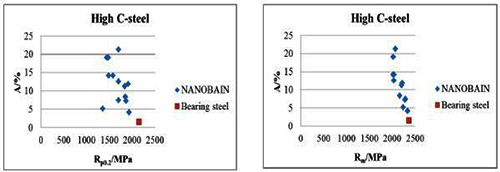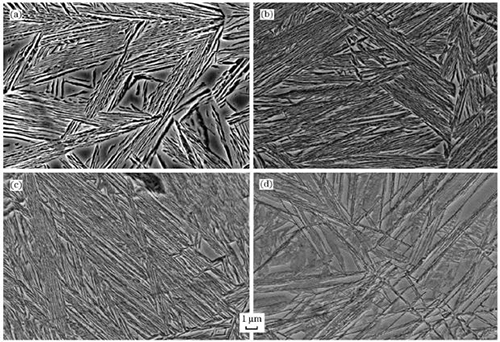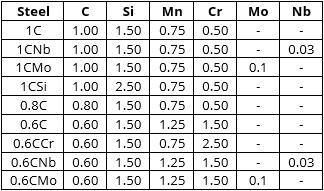NANOBAIN Steels
Abstract
NANOBAIN steels are characterized under the umbrella of nano- engineering, whereby ultra-fine to nanoscale microstructure is achieved through the bainite reaction without the use of severe deformation, rapid heat-treatment or mechanical processing.
NANOBAIN steels offer a potential path to consistently achieve an improved strength, toughness and ductility which normally presents a “trade off” dilemma in commonly known materials.
Fine grained advanced steels exhibit favorable mechanical properties for applications requiring high strength, ductility and impact toughness. These properties result from a microstructure containing a fine distribution of several phases including ferrite, austenite, martensite and bainite. The bainite phase is in the form of fine lamellas of ferrite and carbon enriched austenite which due to proper control of the chemical composition is lacking the nanometre scaled carbides associated with traditional bainite.
On the other hand, there is a growing current awareness of the potential benefits of nanoengineering in the modern steel industry, and leading research and development institutes and companies are pursuing research in the area of nanostructured steels. In this industry, the term ultra-fine grained is generally used to describe steels with average grain sizes between 1 and 2 μm and the term submicron (submicrometre) structure to refer to grain sizes between 100 and 1000 nm. Until recently, effective processing techniques to reduce the grain size of these materials to less than 100 nm did not exist.
In the case of ferritic steels, it is possible to move from ultra-fine to nanoscale by bainite reaction without the use of severe deformation, rapid heat-treatment or mechanical processing. This new generation of steels has been designed in which transformation at low temperature leads to a nanoscale microstructure consisting of extremely fine, 20–40-m-thick, plates of ferrite and retained austenite. These microstructures are achieved through isothermal transformation to bainite of high carbon high silicon steels with low martensite start temperature (~120°C). This is a process similar to that applied to well known commercial steels such as 100Cr6, for particular applications such as diesel injectors or large bearings. Nanostructured bainitic steels present the highest strength/toughness combinations ever recorded in bainitic steels (~2.5 GPa/40MPa m1/2) and exceptional rolling-sliding wear performances.

Figure 1: Yield strength, tensile strength and elongation after fracture of new nanobainitic steels and for conventional bainitic bearing steel 100Cr6 steel
Since the development of high strength steels generally involves a compromise between strength and toughness, the refinement of microstructure is the exclusive method to achieve both strength and toughness at present, as all other strengthening mechanisms such as precipitation hardening harm the toughness. A brand new generation of steels now under development, known as NANOBAIN steel, appears to offer notable strength (2-3 GPa), good toughness (30 MPa m1/2) and ductility (up to 25% in both quasistatic and dynamic loading conditions.

Figure 2: Scanning electron micrographs (SEM) of microstructure after transformation under different conditions: (a) 300°C for 12h (b) 250°C for 48h (c) 210°C for 96°C (d) 180°C for 120h.
In the paper of C. Garcia-Mateo, F.G. Caballero et al., is shown the theoretical approach followed in the design of a new, industrially viable, generation of NANOBAIN steels, a process in which industrial demands such as, simpler chemical compositions, faster transformation kinetics and suffice hardenability have been also considered. The approach is based on the thermodynamic description of the diffusionless nature of bainite, the transformation kinetic model that uses the free energy change of the transformation and finally, some relevant microstructure/properties relationships. The microstructural and mechanical characterization of the bainitic microstructures obtained by isothermal transformation at different temperatures, come to confirm and to validate the theoretical approach used.
Based on the descriptions and calculations described in this study, a group of nine alloys was proposed, see Table 1.

Table 1: Chemical composition of proposed alloys (wt.%).
Find Instantly Thousands of Metallography Diagrams!
Total Materia Horizon contains a unique collection of metallography images across a large range of metallic alloys, countries, standards and heat treatments.

Get a FREE test account at Total Materia Horizon and join a community of over 500,000 users from more than 120 countries.